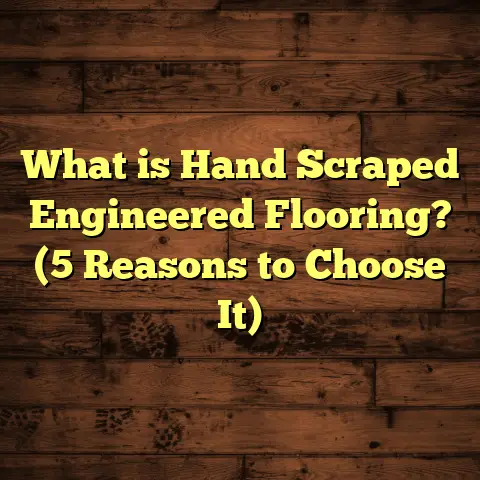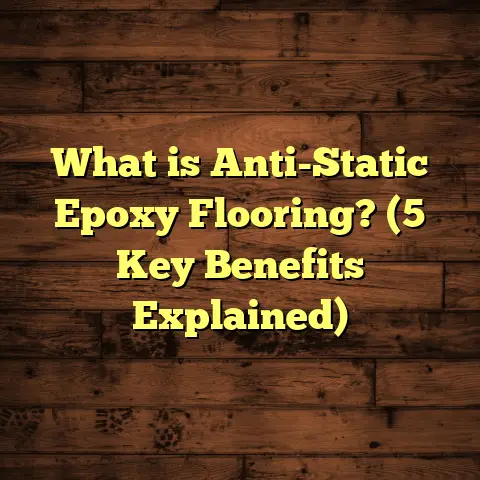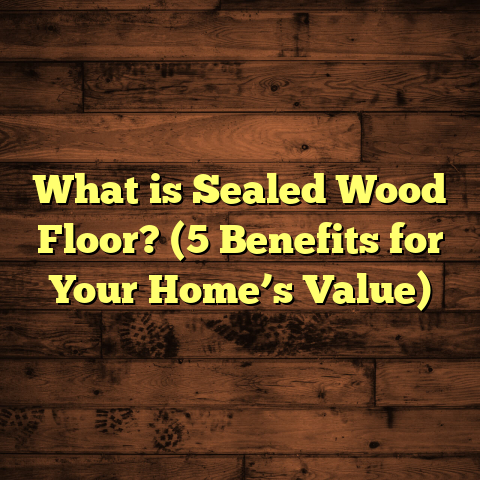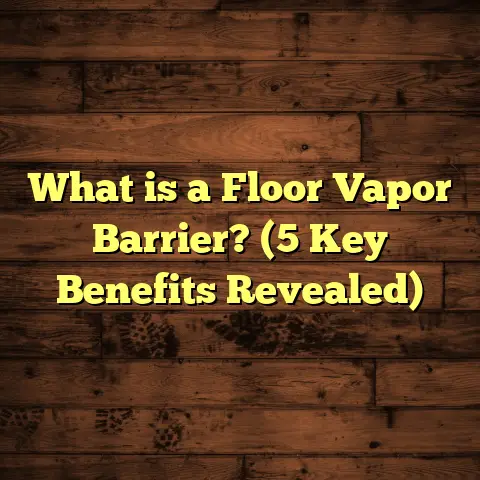What is Plastic Flooring Called? (5 Types You Need to Know!)
Imagine walking across a floor that looks like rich hardwood but feels slightly softer under your feet, or stepping into a room where the surface gleams like polished stone but doesn’t crack or stain after spills. Those contrasting images stuck with me when I first explored plastic flooring options in my early days as a contractor. Plastic flooring isn’t one simple thing—it’s a world of materials engineered to meet a range of needs, styles, and budgets. I’ve worked on dozens of projects involving plastic flooring, and every time, I learn something new about how versatile and practical these materials can be.
So, what is plastic flooring called? Let’s break down five main types you should know about, complete with facts, figures, and stories from my experience to help you figure out which might fit your project best.
What Is Plastic Flooring?
Plastic flooring generally refers to any floor covering made predominantly from synthetic polymers. These polymers can be engineered in different ways to mimic natural materials like wood, stone, or ceramic tile while offering benefits such as water resistance, durability, ease of installation, and affordability.
Unlike hardwood or natural stone floors, plastic flooring is manufactured using materials like polyvinyl chloride (PVC), polyurethane, melamine resin, and other plastics. These materials allow manufacturers to create floors in sheets, planks, or tiles that vary wildly in thickness, texture, and appearance.
When I mention plastic flooring, I’m including several categories:
- Vinyl Flooring: Includes sheets, luxury vinyl tile (LVT), and luxury vinyl plank (LVP).
- Linoleum: A natural polymer-based product often mistaken for vinyl.
- Laminate Flooring: Made of fiberboard topped with a plastic wear layer.
- PVC Flooring Sheets: Large continuous rolls used mainly in commercial settings.
- Plastic Carpet Tiles: Carpet tiles reinforced with plastic backing.
Each type has specific installation methods, thicknesses from as thin as 1.5 mm to over 12 mm, and price ranges tailored to different budgets.
Here’s a quick look at cost ranges I’ve encountered:
| Flooring Type | Thickness Range | Cost per Sq Ft (Material Only) | Installation Cost per Sq Ft | Typical Lifespan |
|---|---|---|---|---|
| Vinyl (LVT/LVP) | 2mm – 8mm | $2 – $7 | $1 – $3 | 10 – 20 years |
| Linoleum | 2.5mm – 4mm | $3 – $6 | $2 – $4 | 20 – 40 years |
| Laminate | 6mm – 12mm | $1.50 – $4 | $1 – $2 | 10 – 25 years |
| PVC Sheets | 1.5mm – 3mm | $2 – $5 | $1.50 – $3 | 10 – 15 years |
| Plastic Carpet Tiles | 5mm – 10mm | $3 – $6 | $1 – $3 | 7 – 10 years |
Location also impacts prices. For example, in urban areas like New York or San Francisco, labor costs are higher by about 20% compared to rural Midwest locations. Installation times can range from one day for small rooms (100-200 sq ft) to several days for large commercial spaces (over 5,000 sq ft).
Now let’s explore each type more deeply.
Vinyl Flooring: The Everyday Workhorse
What Vinyl Flooring Means
Vinyl flooring is probably the most common plastic flooring you encounter. It’s made from polyvinyl chloride resin mixed with plasticizers to make it flexible and additives for color and texture. Vinyl floors come in various forms:
- Sheet Vinyl: Comes in large rolls (usually 6 to 12 feet wide), providing almost seamless coverage.
- Luxury Vinyl Tile (LVT): Individual tiles designed to look like stone or ceramic.
- Luxury Vinyl Plank (LVP): Long planks that replicate hardwood boards.
Vinyl is water-resistant, fairly durable, and easy to clean. It’s often used in kitchens, bathrooms, basements—anywhere moisture might be an issue.
My Personal Vinyl Floor Story
I installed LVP in a family basement last year that was prone to minor flooding during heavy rains. The homeowners wanted the floor to look like natural wood but needed something that wouldn’t warp or stain when wet. We went with a high-end LVP product about 5mm thick with a commercial-grade wear layer of 20 mils (0.5 mm).
The project took two days for a 1,200-square-foot basement. Labor costs were approximately $2 per sq ft; materials came to around $4 per sq ft. Total cost was about $7 per sq ft installed—well within the client’s budget.
The vinyl planks clicked together with a floating floor system—no glue needed—and the floor felt warm and comfortable underfoot compared to tile or concrete.
Data & Performance Insights
According to a recent industry report:
- Vinyl sales have grown by over 8% annually in the US over the past five years.
- Commercial-grade vinyl flooring wear layers typically range from 12 mils (0.3 mm) for residential use up to 28 mils (0.7 mm) for high traffic.
- Average lifespan is about 12-20 years depending on wear layer thickness and maintenance.
- Vinyl floors resist scratches better than laminate but can dent under heavy furniture.
Installation Tips I Follow
- Always acclimate vinyl planks or sheets for at least 48 hours before installation.
- Subfloor must be smooth and dry; imperfections show through thin vinyl.
- Use manufacturer-approved adhesives for glue-down installations.
- For floating floors, leave expansion gaps around edges to prevent buckling.
Vinyl’s versatility means it’s not just practical but also highly customizable—patterns range from faux wood grains to intricate geometric designs.
Linoleum: The Green Alternative
What Linoleum Is Made Of
Linoleum is often confused with vinyl but is made mostly from natural raw materials like linseed oil, pine resin, cork dust, limestone powder, and wood flour. These are mixed and compressed onto a jute backing.
Because it’s natural and biodegradable, linoleum has seen renewed interest among eco-conscious homeowners and businesses.
My Experience With Linoleum Floors
A Montessori school commissioned me to install linoleum across their classrooms totaling roughly 800 square feet. They loved the softness compared to tile or hardwood and appreciated linoleum’s non-toxic composition.
Installation was meticulous; linoleum requires precise adhesive application and at least 24 hours of curing before foot traffic. We used linoleum sheets about 2.5 mm thick with a matte finish.
The school reported that after three years of daily use by children aged 3 to 10, the floors showed minimal wear thanks to regular wax polishing every six months.
Linoleum by the Numbers
- Thickness ranges typically from 2.5mm to 4mm.
- Costs vary: mid-range linoleum costs between $3-$6 per sq ft.
- Overall lifespan ranges from two decades up to four decades if properly maintained.
- It has natural anti-microbial properties due to linseed oil content.
- Installation requires professional skill; improper adhesive can cause bubbling or peeling.
Maintenance Recommendations
Linoleum needs periodic polishing with specialized waxes every six months or so. Avoid harsh chemical cleaners that break down the surface oils.
In my experience, linoleum ages like fine leather—it develops a beautiful patina over time.
Laminate Flooring: Plastic Wear Layer Meets Fiberboard Core
What Laminate Flooring Is
Laminate is a composite flooring made from high-density fiberboard (HDF) topped with a photographic layer that simulates wood grain or stone texture. This print layer is sealed under a clear melamine resin wear layer—the plastic part that gives laminate its durability.
Laminate floors snap together using click-lock systems and typically float over an underlayment rather than being glued down.
Why Laminate Was My Choice for an Urban Rental
I installed laminate flooring in a Chicago rental condo where tenants had dogs and kids who tracked dirt inside daily. The property manager wanted a floor resistant to scratches but still affordable.
We chose a mid-range laminate product about 8mm thick with a wear layer rating of AC3 (moderate commercial use). Installation took one day for approximately 600 square feet.
The laminate held up well for four years before showing minor scuffing near entryways—owners replaced it easily without ripping up subflooring thanks to floating design.
Performance & Costs
- Laminate thickness typically ranges from 6mm to over 12mm.
- Costs vary widely: from budget laminate at $1.50 per sq ft up to premium products at $4 per sq ft.
- Lifespan averages about 10–25 years depending on quality and care.
- Installation costs generally run between $1-$2 per sq ft.
- Water resistance varies; standard laminate is vulnerable to standing water damage unless specifically treated.
Installation Advice I Give
- Use moisture barriers under laminate floors if installing over concrete slabs.
- Choose quality underlayment with soundproofing features for multi-story buildings.
- Avoid excessive water during cleaning; laminate swells when soaked.
- Inspect each plank for defects before installation since damaged pieces weaken floor integrity.
Laminate offers a great balance of style and value if you want wood-look floors without the upkeep of real hardwood.
PVC Sheet Flooring: Seamless & Commercial Grade
What PVC Sheet Flooring Is Used For
PVC sheet flooring is sold in large rolls often between 6–12 feet wide and provides nearly seamless coverage when installed correctly. This makes it ideal for hospitals, laboratories, schools—places needing hygienic surfaces resistant to chemicals and moisture.
My Work on Healthcare Projects
I recently helped renovate a hospital wing covering roughly 5,000 square feet with PVC sheet flooring. The seamless joints welded using hot-air equipment prevented dirt accumulation in seams—a critical sanitary feature.
We selected sheets about 2mm thick with an anti-slip textured surface. The installation lasted five days due to careful subfloor prep and seam welding processes.
The hospital maintenance team reported dramatic reductions in cleaning time versus previous tile floors.
Key Details & Stats
- Thickness usually between 1.5mm – 3mm.
- Cost ranges $2–$5 per sq ft including installation.
- Lifespan typically around 10–15 years depending on use.
- Requires specialized welding tools for seam sealing.
- Resistant to most chemicals, stains, mold, and bacteria growth.
Installation Notes From My Experience
- Subfloors must be perfectly flat; any bumps show through thin PVC sheets.
- Professional seam welding is essential for moisture-proof joints.
- Use recommended adhesives for permanent installations.
- Allow cure time of adhesive before heavy foot traffic—usually around 24 hours.
PVC sheet flooring delivers durability where hygiene matters most—it’s why I often recommend it for medical offices or food prep areas.
Plastic Carpet Tiles: Combining Comfort With Practicality
What Are Plastic Carpet Tiles?
Plastic carpet tiles are modular carpet squares backed with plastic materials such as polypropylene or PVC to provide moisture resistance and durability. They offer softness underfoot while being easy to replace section-by-section if damaged or stained.
How Plastic Carpet Tiles Worked for an Office Renovation
I installed plastic-backed carpet tiles in a tech startup’s office spanning about 1,000 square feet built over an old concrete floor prone to moisture seepage. The client wanted soft surfaces but worried about water damage from occasional spills or leaks.
Tiles were inexpensive (~$4 per sq ft installed) and came in various colors allowing creative design patterns. Installation was quick—about one day—and any damaged tiles could be popped out without disrupting the whole floor.
Useful Facts About Plastic Carpet Tiles
- Thickness ranges from roughly 5mm up to 10mm depending on pile height.
- Costs fluctuate between $3–$6 per sq ft including installation.
- Lifespan tends to be shorter than hard surfaces—seven to ten years on average.
- Installation options include peel-and-stick backs or loose-lay interlocking systems.
- Maintenance requires regular vacuuming plus immediate spot cleaning of spills.
Tips From My Fieldwork
- Choose tiles with stain-resistant treatments if heavy spill risk exists.
- Use quality underlayments for comfort and soundproofing.
- Replace damaged tiles quickly to prevent mold growth underneath.
- Combine different patterns or colors for visually interesting floors.
Plastic carpet tiles marry comfort with practicality—ideal for office spaces or light commercial areas where flexibility counts.
Comparing Plastic Flooring Types Side-by-Side
I’ve summarized key advantages and disadvantages based on my hands-on experience:
| Flooring Type | Advantages | Disadvantages | Best Uses |
|---|---|---|---|
| Vinyl (LVT/LVP) | Water-resistant, versatile designs, durable | Can dent under heavy loads | Kitchens, bathrooms, basements |
| Linoleum | Eco-friendly, anti-bacterial, long-lasting | Requires expert installation & waxing | Classrooms, eco homes |
| Laminate | Affordable, easy install, wood look | Less water-resistant | Living rooms, bedrooms |
| PVC Sheets | Seamless surface, hygienic | Professional installation needed | Hospitals, labs, commercial |
| Plastic Carpet Tiles | Comfortable, modular replacement | Shorter lifespan | Offices, light commercial |
Cost Breakdown Examples From Real Projects
Here are detailed cost breakdowns from projects I’ve completed recently involving plastic flooring:
Project A: Residential Basement Renovation
Floor Area: 1,200 sq ft
Floor Type: Luxury Vinyl Plank (LVP)
Material Cost: $4/sq ft → $4,800
Labor Cost: $2/sq ft → $2,400
Total Cost: $7,200
Installation Time: 2 days
Notes: Floating floor system over concrete slab; included moisture barrier installation
Project B: Montessori School Classrooms
Floor Area: 800 sq ft
Floor Type: Linoleum Sheet
Material Cost: $5/sq ft → $4,000
Labor Cost: $3/sq ft → $2,400
Total Cost: $6,400
Installation Time: 3 days
Notes: Adhesive curing time extended schedule; required waxing every six months
Project C: Hospital Wing Renovation
Floor Area: 5,000 sq ft
Floor Type: PVC Sheet Flooring
Material Cost: $3/sq ft → $15,000
Labor Cost: $2.50/sq ft → $12,500
Total Cost: $27,500
Installation Time: 5 days
Notes: Seam welding critical for hygiene compliance
Project D: Corporate Office Fit-Out
Floor Area: 1,000 sq ft
Floor Type: Plastic Carpet Tiles
Material Cost: $3/sq ft → $3,000
Labor Cost: $1.50/sq ft → $1,500
Total Cost: $4,500
Installation Time: 1 day
Notes: Modular tiles allowed quick replacement of damaged areas
How To Choose The Right Plastic Flooring For Your Needs
When clients ask me which plastic flooring they should choose, I focus on these questions:
Where will the floor be installed? Moisture-prone areas need waterproof options like vinyl or PVC sheets. Dry living spaces can handle laminate or carpet tiles easily.
What’s your budget? Laminate generally offers the lowest upfront material cost but may not last as long in wet environments. Linoleum has higher installation costs but lasts decades.
How much traffic will the floor see? Commercial spaces require thicker wear layers or industrial-grade sheets while homes can opt for residential grades.
Do you want eco-friendly materials? Linoleum stands out here as naturally biodegradable versus fully synthetic vinyl or laminate.
How much maintenance are you willing to do? Linoleum needs waxing; vinyl only requires basic cleaning; carpet tiles need regular vacuuming and quick stain treatment.
Final Thoughts From My Journey With Plastic Floors
Every plastic flooring project teaches me something new about balancing aesthetics with function and budget constraints. These materials have come a long way since their early days as cheap alternatives. Today’s plastic floors offer realistic looks—wood grains so convincing even hardwood lovers get fooled—and practical benefits like water resistance and easy upkeep that homeowners crave.
If you’re thinking about installing plastic flooring yourself or hiring pros like me:
- Measure your space carefully; add at least 5% extra material for waste.
- Get multiple quotes—prices vary widely by region and installer experience.
- Consider using tools like FloorTally online calculators—they help estimate local material/labor costs quickly based on your exact project specs.
- Ask suppliers about wear layer thicknesses and warranties—it makes a big difference in how long your floor lasts.
- Don’t rush installation; proper subfloor prep prevents problems later like buckling or bubbles.
Got questions? Need advice on matching styles or DIY tips? Just reach out—I’m happy to share what I’ve learned installing thousands of square feet of plastic flooring over the years.
Plastic flooring might just surprise you with its performance—and maybe even become your favorite type of floor!





